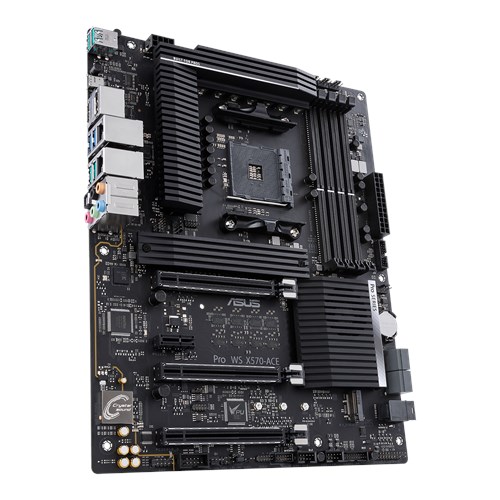The AMD X570 Motherboard Overview: Over 35+ Motherboards Analyzed
by Gavin Bonshor on July 9, 2019 8:00 AM ESTASUS Pro WS X570-Ace
The ASUS Pro WS X570-Ace is one of the more interesting models from the launch day X570 models. Firstly it's aimed primarily at professional and workstation users, which is signified in the model number (WS). What makes the ASUS Pro WS X570-Ace so interesting is that its X570 chipset fed bottom full-length PCIe 4.0 slot is wired at x8, and not the conventional PCIe 4.0 x4 as seen on other X570 models. The WS X570-Ace also includes dual Gigabit networking, a premium Realtek ALC1220A HD audio codec, and a PCIe 4.0 U.2 port.

The ASUS Pro WS X570-Ace follows a different design from the rest of its motherboard line-up, with straight angled finned heatsinks, following a uniformed black design with the horizontally placed fins. Compared with the other ASUS X570 models, the overall feature set is a little thin due to its workstation focused design. One of the main focal points of the ASUS WS X570-ACE ATX motherboard includes three full-length PCIe 4.0 slots which operate at x16, x8/x8, and x8/x8/x8, with that last x8 coming from the chipset. with a single PCIe 4.0 x1 slot also present. For most X570 models announced, this is one of the only models to optimize all three full-length slots at a minimum of x8.
Storage options on the Pro WS X570-Ace consist of two PCIe 4.0 x4 M.2 slots with a single U.2 port and four SATA ports that feature support for RAID 0, 1, and 10 arrays. As with other ATX sized ASUS X570 models, the Pro WS X570-Ace has four memory slots with support for a total capacity of up to 128 GB. Users can also have the option to use either ECC and non-ECC memory which is dependant on the processor installed.
The two Ethernet ports on the rear panel are controlled by an Intel I211-AT and Realtek 8117 which are both Gigabit NICs, while the onboard audio is powered by a Realtek S1220A HD audio codec; this provides five 3.5 mm audio jacks and a S/PDIF optical output. Super fast connectivity is strong with four USB 3.1 G2 Type-A, one USB 3.1 G2 Type-C, and two USB 3.1 G1 Type-A ports. For users looking to utilize compatible Ryzen APUs, ASUS has included a pair of video outputs consisting of HDMI and a DisplayPort.
The ASUS Pro WS X570-Ace has an MSRP of $380 and shifts focus directly on users looking to create a Ryzen 3000 powered workstation. Its subtle and straight-forward design also makes this a good option for users looking to avoid the more gaming-themed RGB splattered models, and create a somewhat elegant looking system.











225 Comments
View All Comments
abufrejoval - Tuesday, July 9, 2019 - link
It's amazing how quickly you run out of PCIe lanes, when you don't have switches to multiplex and translate between PCIe revisions and lanes (e.g. PCIe v4 x2 <-> PCIe v2 x8).I find myself using USB 3.x NBase-T NICs and NVMe adapters, simply because they *do* switch.
Bensam123 - Tuesday, July 9, 2019 - link
Maybe a bit more depth on the power delivery page. I have absolutely no idea how to go about parsing what's there. More chokes is better? What denotes a power phase?A5 - Tuesday, July 9, 2019 - link
+1. Some analysis of that information would be helpful.MrSpadge - Tuesday, July 9, 2019 - link
+1bunkle - Wednesday, July 10, 2019 - link
The controller column includes the total number of phases supported split between CPU cores and SoC e.g. (6+1) = 6 CPU phase and 1 SoC phase. More is *usually* better but has diminishing returns regarding tighter and tighter voltage regulation. Some controllers are better than others (can operate at high frequency e.g. 500KHz v 1000KHz, include other features to improve performance) mitigating the need for more phases.Each phase is a buck converter comprised of a low/high side MOSFET (can be integrated in a single package) and choke. Some controllers can support doubling up the PWM signal to driver more MOSFETs. Doublers can also be added as discrete components if not built into the controller.
Current rating of the MOSFET (e.g. Sic639=40A IR3555=60A) indicates the total power deliverable. MOSFETs are not 100% efficient and vary in efficiency. The more current they provide the hotter they get and the less efficient they become, with better MOSFETs producing less heat for a given current. Thus using doubles can improve temperatures and efficiency without the benefits of the tighter voltage tolerance that *real* phases provide.
Hope that’s helpful!
bunkle - Wednesday, July 10, 2019 - link
A lot more detailed explanation: https://en.wikichip.org/wiki/voltage_regulator_mod...bug77 - Tuesday, July 9, 2019 - link
The description for AsRock X570(M) Pro4 says "5 jack + 1 SPDIF". Unfortunately, those boards lack SPDIF and only come with 3 jacks ;)Smell This - Tuesday, July 9, 2019 - link
I'm thinking the *ASRock Thunderbolt AIC* ...https://thunderbolttechnology.net/product/asrock-t...
would cover all your TBT peripheral needs, including optical.
DanNeely - Tuesday, July 9, 2019 - link
Do X570 boards still need an extra chip per USB port to support USB-C reversibility?The additional expense and needed PCB space were cited as among the reasons why earlier generation boards (IIRC both Intel and AMD) almost never had more than 1 C port; but it was never clear to me if that was an inherent implementation penalty for the C port or an artifact of Intel's tech stack being stalled out and AMD outsourcing to ASMedia which built the chipsets on an ancient (55nm) platform.
DigitalFreak - Tuesday, July 9, 2019 - link
Gavin - X370 and X470 only supported PCIe 2.0. The connection between the CPU and chipset was 3.0, but all the ports on the chipset were 2.0.